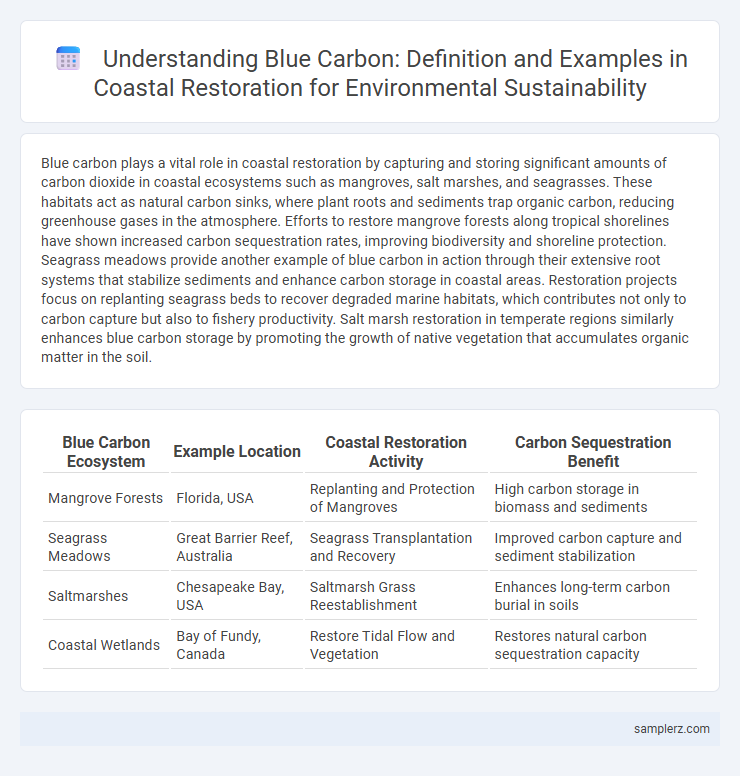Blue carbon plays a vital role in coastal restoration by capturing and storing significant amounts of carbon dioxide in coastal ecosystems such as mangroves, salt marshes, and seagrasses. These habitats act as natural carbon sinks, where plant roots and sediments trap organic carbon, reducing greenhouse gases in the atmosphere. Efforts to restore mangrove forests along tropical shorelines have shown increased carbon sequestration rates, improving biodiversity and shoreline protection. Seagrass meadows provide another example of blue carbon in action through their extensive root systems that stabilize sediments and enhance carbon storage in coastal areas. Restoration projects focus on replanting seagrass beds to recover degraded marine habitats, which contributes not only to carbon capture but also to fishery productivity. Salt marsh restoration in temperate regions similarly enhances blue carbon storage by promoting the growth of native vegetation that accumulates organic matter in the soil.
Table of Comparison
| Blue Carbon Ecosystem | Example Location | Coastal Restoration Activity | Carbon Sequestration Benefit |
|---|---|---|---|
| Mangrove Forests | Florida, USA | Replanting and Protection of Mangroves | High carbon storage in biomass and sediments |
| Seagrass Meadows | Great Barrier Reef, Australia | Seagrass Transplantation and Recovery | Improved carbon capture and sediment stabilization |
| Saltmarshes | Chesapeake Bay, USA | Saltmarsh Grass Reestablishment | Enhances long-term carbon burial in soils |
| Coastal Wetlands | Bay of Fundy, Canada | Restore Tidal Flow and Vegetation | Restores natural carbon sequestration capacity |
Introduction to Blue Carbon in Coastal Restoration
Blue carbon refers to the carbon captured and stored by coastal and marine ecosystems such as mangroves, salt marshes, and seagrasses, playing a crucial role in mitigating climate change. These ecosystems sequester large amounts of carbon dioxide from the atmosphere, storing it in both plant biomass and sediment for centuries. Coastal restoration projects that rehabilitate these habitats enhance carbon storage capacity while providing biodiversity benefits and improving coastal resilience against storms and erosion.
Mangrove Forests: Key Blue Carbon Sinks
Mangrove forests serve as vital blue carbon sinks, sequestering up to four times more carbon per hectare than terrestrial forests. These coastal ecosystems stabilize shorelines, enhance biodiversity, and mitigate climate change by storing significant amounts of carbon in both biomass and sediment. Restoration projects targeting degraded mangroves effectively increase coastal resilience and carbon sequestration capacity, making them a crucial element in blue carbon strategies.
Seagrass Meadows and Their Carbon Storage Potential
Seagrass meadows play a critical role in blue carbon ecosystems by sequestering significant amounts of atmospheric CO2 and storing it in their biomass and sediments. These coastal habitats can capture carbon at rates comparable to tropical forests, making them essential for mitigating climate change. Restoration efforts targeting seagrass meadows enhance carbon storage capacity, improve biodiversity, and protect shorelines from erosion.
Salt Marshes: Coastal Guardians and Carbon Reservoirs
Salt marshes serve as vital blue carbon ecosystems, trapping and storing significant amounts of carbon dioxide in their dense vegetation and rich soils. These coastal wetlands act as natural buffers against storm surges while enhancing biodiversity and water quality. Restoration efforts in salt marshes promote carbon sequestration, mitigate climate change, and protect vulnerable shorelines from erosion.
Restoring Tidal Wetlands for Enhanced Blue Carbon
Restoring tidal wetlands significantly boosts blue carbon storage by enhancing the natural capacity of salt marshes to sequester atmospheric CO2 in soil and vegetation. Projects in areas like the Chesapeake Bay have demonstrated that rehabilitating tidal flow and native plant communities increases carbon accumulation rates, while also improving biodiversity and resilience to sea-level rise. These efforts contribute to climate change mitigation by preserving and expanding critical coastal blue carbon ecosystems.
Sustainable Aquaculture and Blue Carbon Integration
Sustainable aquaculture integrates blue carbon principles by restoring mangrove forests and seagrass meadows, which act as significant carbon sinks while enhancing biodiversity and water quality. Coastal restoration projects that combine aquaculture with blue carbon ecosystems improve carbon sequestration rates and create resilient habitats that support fish populations and coastal protection. These practices reduce carbon emissions and promote sustainable livelihoods, driving climate mitigation in coastal zones.
Case Study: Community-led Mangrove Restoration Projects
Community-led mangrove restoration projects exemplify successful blue carbon initiatives by enhancing carbon sequestration in coastal ecosystems. These projects restore degraded mangrove forests, which act as vital carbon sinks, trapping large amounts of atmospheric CO2 while supporting biodiversity. Case studies reveal that active community involvement increases project sustainability and effectiveness in mitigating climate change impacts.
Policy Initiatives Supporting Blue Carbon Restoration
Policy initiatives such as the Blue Carbon Initiative and the United Nations Framework Convention on Climate Change (UNFCCC) actively support coastal restoration by promoting the conservation and sustainable management of mangroves, salt marshes, and seagrasses. National governments have integrated blue carbon ecosystems into their Nationally Determined Contributions (NDCs) under the Paris Agreement, incentivizing carbon sequestration projects through climate finance mechanisms. Regional programs like the Coral Triangle Initiative also foster collaboration to enhance blue carbon stock preservation, aligning environmental goals with socioeconomic benefits.
Monitoring and Measuring Blue Carbon in Coastal Ecosystems
Monitoring and measuring blue carbon in coastal ecosystems involves quantifying carbon stocks within mangroves, salt marshes, and seagrasses using remote sensing technology and soil core sampling. Advanced methods such as LiDAR mapping and satellite imagery enhance accuracy in tracking ecosystem changes and carbon sequestration rates over time. Integrating these techniques supports effective coastal restoration projects by providing data essential for carbon credit schemes and climate mitigation strategies.
Future Prospects for Blue Carbon in Climate Action
Mangrove reforestation and seagrass meadow restoration represent high-potential blue carbon strategies for enhancing carbon sequestration in coastal ecosystems. Emerging technologies in carbon monitoring and valuation improve the accuracy of blue carbon credits, incentivizing investment in long-term coastal habitat protection. Expanding blue carbon initiatives aligns with global climate targets by simultaneously promoting biodiversity, coastal resilience, and greenhouse gas mitigation.

example of blue carbon in coastal restoration Infographic
 samplerz.com
samplerz.com